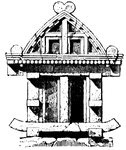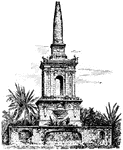The Death Care ClipArt gallery offers 103 illustrations of cemeteries, caskets, and other items related to funerals and burial.
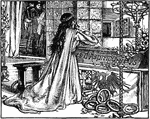
Dead Love
Dead Love is a drawing that was created by M.J. Lawless in 1862. It is found in "The Good Fight" by…
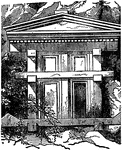
Lycian Tomb
"Lycia was, in ancient geography, a country on the S. coast of Asia Minor, extending toward Mount Taurus,…
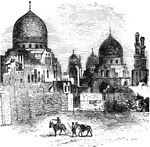
Mamluk Tomb
Tombs of the Mamluks at Cairo. The Mamluks were slave soldiers who served the Muslim caliphs and the…
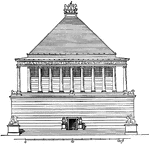
Mausoleum at Halicarnassus
The Mausoleum at Halicarnassus was a tomb built between 353 and 350 BC at Halicarnassus (present Bodrum,…

Sarcophagus of Menkera
"The third pyramid on the ridge of Gizeh was built by Menkera, a successor of Khafra and fourth or fifth…
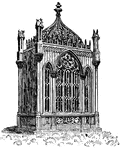
Tomb of Monroe
The tomb of the fifth President of the United States, James Monroe. His grave is at Hollywood Cemetery…

Mummy Coffin
An illustration of a mummy coffin. The mummy was typically wrapped in linen and placed many nesting…
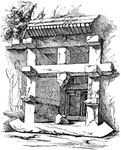
Tomb at Myra
"The second class, those cut in the rock, have either sculptured facades, or a kind of frame standing…

Tomb of Nævoleia Tyche at Pompeii
"For tombs of smaller dimensions various forms and abnormal decorations were employed. An ornamented…
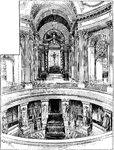
Tomb of Napoleon Bonaparte
An illustration of the tomb of the sarcophagus of Napoleon Bonaparte located in the Church of the Hotel…
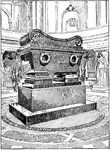
The Tomb of Napoleon
"In 1840 Napoleon's body was removed from St. Helena, taken with great pomp to Paris, and deposited…
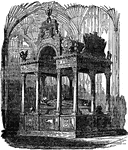
Queen Elizabeth's Tomb
"Queen Elizabeth's Tomb: In the North Aisle of Henry VII's Chapel, Westminster Abbey." — Chambers,…
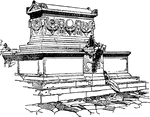
Sarcophagus
"Sarcophagus from the Street of Tombs at Assos in the Troad, excavated by the Archaeological Institute…

Ancient Egyptian Sarcophagus
A sarcophagus is a funeral receptacle for a corpse, most commonly carved or cut from stone. The word…

Sarcophagus of Scipio
"Sarcophagus, plural Sarcophagi, is a kind of stone used among the Greeks for making coffins, and so…
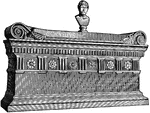
Sarcophagus of Scipio Barbatus
Sarcophagus of Lucius Cornelius Scipio Barbatus, an elected Roman consul in 298 BC.

Sarcophagus of Washington
"The sarcophagus of Washington. This was placed in the family vault in the autumn of 1837."—Lossing,…

Stele-Crest
The Stele-crest is a Greek tomb-tone. It is an upright tablet that bears an inscription with decoration…
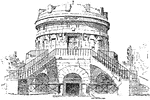
Tomb of Theodoric at Ravenna
An ancient monument built in 520 CE by Theodoric the Great as his future tomb.

Tomb of Theodoric at Ravenna
"The two-storied marble structure is capped by an enormous monolith weighing over 300 tons."—Webster,…
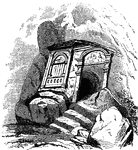
Tomb
Tombs hewn in the rock at Petra, an old Arabian city located in Ma'an, a governorate of Jordan, which…
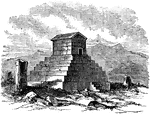
Tomb of Cryus
The Tomb of Cyrus is the burial place of the ancient Cyrus the Great of Persia. Cyrus the Great was…

Tomb of Sultan Humayun
The tomb of Sultan Humayun in Delhi, India is an example of Indo-Saracenic architecture.

Roman Sarcophagus Tomb
A coffin or tomb of stone; a kind of stone chest, generally more or less ornamented for receiving a…
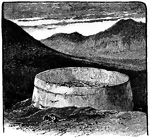
Tower of Silence Built by the Parsees
"A tower, generally built about 25 feet high, on which the Parsees expose the bodies of their dead to…
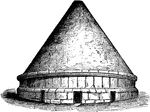
Tumuli
The most interesting monuments of Etruscan architecture which have been preserved are the tombs. They…
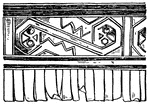
Tomb of Incas Valence
The tomb of Incas valence is found in Ancon, Peru. It is a hanging textile termination with the lower…
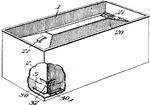
Burial Vault
A sturdy box designed to protect the coffin inside of it. The body is placed within the coffin, which…

Glazed Coffins, from Warka
"Another kind of coffins employed by the Chaldeans consisted of two large earthenware vessels, shaped…

Washington's Bier
"The bier which Washington was carried to the tomb at Mount Vernon."—Lossing, 1851
